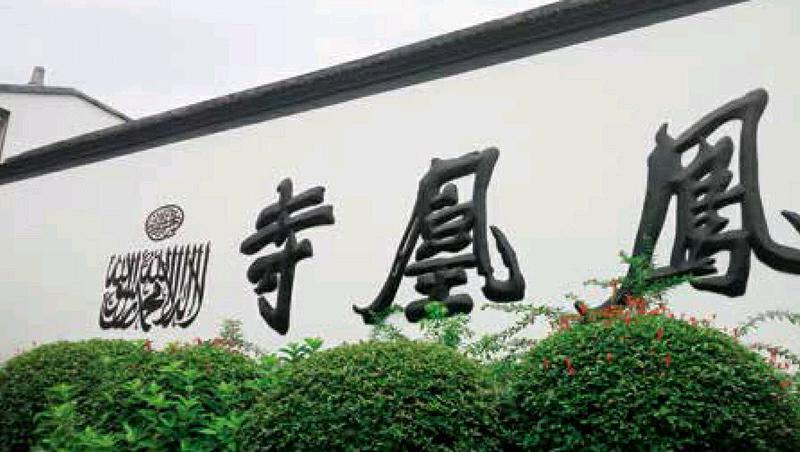凤凰寺:探源古代“一带一路”
丁山
杭州西湖大道北侧,南宋御街之中山中路227号,繁盛的街市忽地出现一处规模颇巨的伊斯兰清真寺院,一派浓郁的阿拉伯建筑风格,庄重,优雅,安谧。若遇开放之时,你还可以循步其中,在寺内各文物点参观。它便是与广州狮子寺、泉州麒麟寺、扬州仙鹤寺并称、我国南方伊斯兰教四大古寺的杭州凤凰寺。毫不夸张地说,如今得到各国响应的中国“一带一路”倡议,还能从凤凰寺探寻出其渊源。
凤凰寺又名礼拜寺、真教寺、回回堂,因当年的整个建筑群布局形似凤凰展翅,故于清道光十八年(1838)改称凤凰寺。据史书记载,凤凰寺规模鼎盛期,其占地面积较之现存大一倍以上。如今,倘若站在寺院北侧跨越西湖大道的御街人行天桥上向南俯视,但见屋宇错落,楼塔相叠,檐角重重,不凡气势扑面而来。
作为一座设施完备的清真寺,凤凰寺在结构和功能上具备浓郁的阿拉伯建筑风格,而在总体布局、建筑形制、建筑装饰等方面,又明显融合了中国传统建筑艺术。
缘自中-西亚贸易和文化交流
宋元时期,杭州进入了高速发展期。南宋时为国都,元时为江浙行省首府,人口达百万以上。中国陆上丝绸之路最主要的三大商品丝绸、瓷器、茶叶,均乃杭州一带的传统优势产品。随着海上丝绸之路的开辟,加之大运河商品流通的功能得以显现,杭州商品经济日益发达,使其逐渐成为中国东南沿海国际性大都市。
“羊坝头”地名由“洋坝头”讹化而来。汉时,此地为一片海涂,潮水时常滋扰。为免受海侵,这一带筑起一条御海大坝,称为“洋坝”。隋唐以后海上贸易兴盛,洋坝头港成为重要的货物进出口集散地,来自中西亚、欧洲、非洲的丝绸、瓷器、茶叶、香料、珠宝商人在此云集,且以阿拉伯人、波斯人为数最多,他们中的不少人还在此定居。
贸易和文化交流的繁盛,使得开辟宗教礼拜活动场所成为一种必需,穆斯林清真寺院便在羊坝头港(宋时又称文锦坊)附近出现。而关于此寺的始建年代,据清康熙九年(1670)《重修真教寺碑》记载:“寺创自唐,毁于季宋,元代辛巳年有大师阿老丁者,来自西域,息足于杭,瞻遗址而慨然捐金,为鼎新之举,表以崇闳,缭以修庑,焕然盛矣。”分析史料可知,凤凰寺可能始建于唐贞观年间,南宋嘉泰三年毁于战乱,元延祐年间由“回回大师”阿老丁主持重建。
据载,明景泰年间该寺重修,使凤凰寺形成建筑群。惜明崇祯年间遭遇火患,部分建筑毁坏。清顺治五年(1648)、康熙九年(1670)、道光五年(1825),清廷数次出资修建凤凰寺,规模达到现存的两倍左右,使该寺成为当时中国规模最巨的清真寺之一。显然,各代扩修凤凰寺的目的,也与加强中-西亚贸易和文化交流有关。民国17年(1928),杭州辟建中心马路(今中山中路),原五层塔式大门、照壁、长廊及门前的一对石马被拆除,寺院地盘随之缩小。
新中国成立后,政府多次拨款修建凤凰寺,1953年的那一次可谓工程浩大:整修了老大殿、复建了与老大殿相连的新大殿、修建了碑廊、绿化了庭院,使全寺占地面积达3300平方米,主要建筑格局形成且保存至今。2009年,五层木制望月楼重现门厅之上,更显整体建筑格局的完整性。1961年,凤凰寺被列为“浙江省重点文物保护单位”。2001年被列为“全国重点文物保护单位”。
珍贵碑石记录真实历史印痕
凤凰寺内北墙建有碑廊,内存阿拉伯文、波斯文碑石24块。1974年,凤凰寺管委会在寺内庭院左侧专门修建了一间小屋,明永乐、弘治敕谕碑和清顺治、康熙年间重修寺碑记等若干寺碑也集中收存于此。
凤凰寺所藏的墓碑,石质、刻纹均极为讲究。相较于泉州麒麟寺等处所藏大部分墓碑,其墓碑尺寸相对较大,所载铭文内容丰富,不单有墓主姓名、生卒年,《古兰经》经文句子等,还镌有墓主生平介绍、主要功绩,乃至波斯语诗歌片段等。碑上既有波斯文,也有阿拉伯文。
国内外学界对凤凰寺所藏碑石铭文的释读,一直极为关注。早在1911年,聚景园石碑照片就刊载于英国报纸。1936年,回族史学家白寿彝先生在民国史地学术刊物《禹贡》第11期上发表文章,介绍民国以来从该公墓出土的古阿拉伯文、波斯文墓碑相关史料,并公布了两通拓片。英国伦敦大学阿拉伯文碑铭释读专家亚历山大·莫尔顿及弟子乔治·兰天浪博士对此潜心研究,取得一批研究成果。2010年以来,杭州市启动这批古碑铭文的转译和释读研究,北京大学、中国人民大学、南开大学、南京大学和浙江大学等高校和研究机构的专家学者组成学术研究团队,投身其中。伊朗德黑兰大学、英国伦敦大学、福建省社会科学院中国与海上丝绸之路研究中心等专家学者也积极参与。2015年,中华书局正式出版发行《杭州凤凰寺藏阿拉伯文波斯文碑铭释读译注》,是对这批碑铭的首次释读,有力地实证了杭州当时的国际化发展水平和古代“一带一路”重要起讫点的盛况。
杭州为何成为古代“一带一路”起讫点?
史载,汉唐时期,杭州出产的丝绸即通过丝绸之路运往西域各国。南宋年间,中国历史上最早的外贸仓储就出现在临安(杭州),元时,杭州和泉州之间设立过“海站”,专门用来转运舶货贡品到大都(北京)。据阿拉伯文献记载,在当时的钦察汗国首都拔都萨莱(地处今俄罗斯伏尔加河流域)就能买到杭州的丝绸。
杭州之所以成为古代中国与西方“一带一路”的重要起讫点,是因为它拥有得天独厚的地理位置和交通条件。元朝都城大都与杭州有运河相连,阿拉伯、波斯海商在印度西南部进行贸易中转后,下一个目的地往往是中国沿海地区。享有河运、海运、仓储之便,尤其是拥有丰富物产,且直达元朝大都的杭州显然是商贾首选。在海上丝绸之路畅通的同时,陆上丝绸之路也常以杭州为始点。
凤凰寺珍贵古碑铭文除了记载凤凰寺沿革史,留存古代杭州回民风俗等珍贵历史记忆,更重要的是记录了当年杭州与丝绸之路沿线各国的贸易和文化交流。古碑铭文表明,所有墓碑均屬元代之物,碑主大多为拥有相当社会地位的商人、官员和宗教人士等。在这些墓主人中,有波斯人、阿拉伯人、中亚人和突厥人。endprint
從墓碑所镌墓主生平介绍中,还可得悉他们是怎样来到杭州的,在杭期间主要从事何种职业,还能得知他们曾为杭州与中亚及至西方的贸易和文化交流做出怎样的贡献。他们中的大多数经陆路抵达杭州,部分经海路抵达,有的还经元大都来到这里。一位名叫阿老马迪·德尔马契的波斯人,来此主要从事传教活动,另有不少墓主生前则在贩运丝绸、瓷器、茶叶及细香料、药材和宝石等物产的同时,还带来了西域各个门类的艺术,包括诗歌、绘画、音乐、建筑等方面的文化精华。
中国与西亚乃至西方贸易和文化交流,肇始于汉唐时期,元代达到巅峰。如今中国所倡议之“一带一路”愿景和行动,倘若追溯历史,可以说那时已经显露端倪。作为杭州存世至今的重要历史建筑,凤凰寺无疑是古代中国“一带一路”的重要象征。多少年过去了,它依然深情诉说着绵长悠远的动人故事。
The Phoenix Temple, a place of worship for followers of Islam in Hangzhou, is situated at 227 Central Zhongshan Road, to the north of West Lake Avenue. The architectural style oozes magnificence, serenity, grace. It is one of the four major ancient mosques in southeast Chinas coastal areas. The other three are the Lion Temple in Guangzhou, the Qilin Temple in Quanzhou and the Crane Temple in Yangzhou.
In history, the mosque in Hangzhou had other names in different times and to different people. It officially became Phoenix Temple in 1838 after a major restoration project. The name has remained unchanged since then, but the current complex is only half of what it was at its climax in the Qing Dynasty. The mosque functions as a place of worship for followers of Islam, but its layout and decoration features elements of Chinese architecture.
The mosque is situated at a place where business prospered in the Song (960-1279) and the Yuan (1279-1368), a period when Hangzhou as a city boomed. In the Yuan, the citys population amounted to 1 million, largely thanks to the wealth accumulated through international trade of silk, porcelain and tea, all major products made in Hangzhou and neighboring regions. In very ancient times, part of Hangzhou was in the sea. In the Tang dynasty, international trade in Hangzhou flourished and traders from west and central Asia, Europe and Africa set up their communities in the city. The Arabians and the Persians gravitated. In the Yuan, the Muslin community had about 60,000 residents. A former royal garden of the Southern Song Dynasty, which had become ruins in the Yuan, was purchased by the Muslin community to serve as a cemetery.
Hangzhou had its mosque in the Tang Dynasty (618-916). The mosque was destroyed several times in history. It was ravaged in war in the Southern Song Dynasty. After a reconstruction in the Ming (1368-1644), the architecture took the shape of a phoenix. Then it came down in a fire toward the last years of the Ming. In 1648, 1670, and 1825, the Phoenix Temple experienced refurbishment and expansion three times, thanks to the funds from the national government. It became one of the major mosques in China.endprint
In 1928, the five-tiered tower-like gate, the screen wall behind the gate, a long corridor, and a pair of stone horses in front of the gate of the mosque were removed to make room for the main street, which is Central Zhongshan Road today.
Since the founding of the Peoples Republic in 1949, the government has funded several major restoration and refurbishment projects for the time-honored temple. The project in 1953 was gigantic. The old prayer hall was refurbished, and a new prayer hall was reconstructed to connect with the old one; a corridor of steles was built, and the whole complex was landscaped. After the restoration, the complex measured about 3,300 square meters. In 2009, the five-tier gate structure, which was removed in 1928, was restored to make the complex complete. In 1961, the mosque was listed as a key cultural relic unit under the provincial governments protection. In 2001, it was inscribed as a national cultural relic.
The steles now housed at the stele corridor add a special touch to the uniqueness of the mosque. In the collection are 24 tombstones in the Arabian and Persian languages, collected from the Muslin cemetery which disappeared in the citys ups and downs. Also in the collection are a number of steles in Chinese, two bearing the edicts of two emperors of the Ming Dynasty and the steles bearing accounts of the restoration projects in the Qing Dynasty.
The tombstones at the mosque are quite unique. Unlike the similar tombstones in the collection of Qilin Temple in Quanzhou, these tombstones in Hangzhou are larger and inscriptions are longer with more information about the dead. The rubbings of two tombstones from the Muslin cemetery in Hangzhou were published in a newspaper in UK in 1911. In 1936, Bai Shouyi, a scholar specialized in the history of Chinese muslins, published a general review on the tombstones unearthed from the former Muslin cemetery in Hangzhou. His study interested some scholars. In 2010, two UK scholars made public two research papers based on the review of Bai Shouyi at a forum in Hangzhou. In 2010, Hangzhou launched a research project on the 24 tombstones. A number of prestigious universities were engaged. The research results were put into a book and published in 2015 by Zhonghua Book Company. The papers give Chinese translations of the tombstone inscriptions and explain how these people came to Hangzhou and what they did in their lifetime. One of the conclusions is obvious: Hangzhou acted as the departure and destination city of Chinas Silk Routes both across the continents and on the seas in ancient times.endprint

